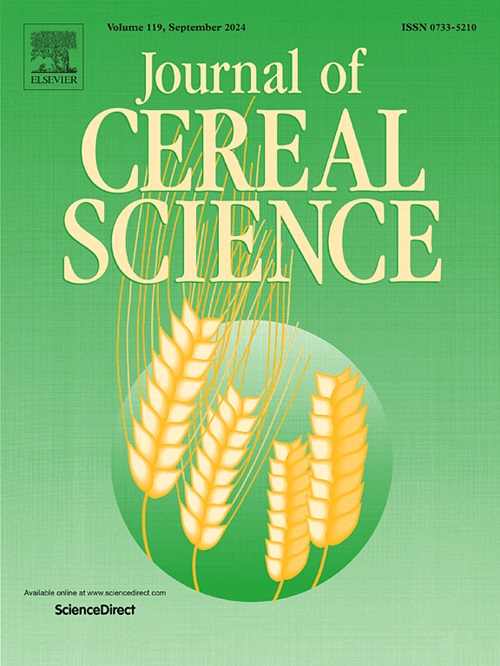通过GWAS解码大米淀粉粘度揭示了食用和烹饪质量的新位点
IF 3.7
2区 农林科学
Q2 FOOD SCIENCE & TECHNOLOGY
引用次数: 0
摘要
快速粘度分析仪(RVA)已成为全面客观评价大米食用和烹饪质量(ECQ)的有用工具,在模拟烹饪过程中提供精确的淀粉粘度特性定量。为了剖析ECQ的遗传基础,我们对两种环境下的439个遗传多样性水稻材料进行了全基因组关联研究(GWAS),并鉴定出10个与RVA谱参数相关的稳健数量性状位点(qtl)。6个位点(qRVA-1.1、qRVA-1.2、qRVA-3、qRVA-5、qRVA-8和qRVA-11)与6个RVA谱特性相关联,显示了它们在RVA参数调控中的重要性。值得注意的是,qRVA-6.1与直链淀粉含量(AC)和凝胶浓度(GC)的典型调节因子Wx基因座共定位,并影响分解值(BDV)、冷糊粘度(CPV)、稠度值(CSV)、热糊粘度(HPV)和挫折值(SBV)。两个新的位点qRVA-2和qRVA-10分别与降解动力学(SBV/CSV)和淀粉稳定性(BDV/CPV)相关。通过基于单倍型的分析,我们优先排序了6个候选基因(LOC_Os01g65780、LOC_Os01g65880、LOC_Os02g53620、LOC_Os03g40440、LOC_Os10g34520和LOC_Os11g01580),这些基因具有显著改变RVA谱的非同音突变或结构变异,突出了它们作为淀粉粘度特性关键调控因子的潜力。通过将RVA表型分析与遗传定位相结合,本研究为ECQ的分子机制提供了新的见解,并为培育具有优越烹饪特性的水稻品种提供了有价值的qtl和候选基因。本文章由计算机程序翻译,如有差异,请以英文原文为准。
Decoding rice starch viscosity via GWAS reveals novel loci for eating and cooking quality
The Rapid Viscosity Analyzer (RVA) has emerged as a useful tool for comprehensive and objective evaluation of rice eating and cooking quality (ECQ), offering precise quantification of starch viscosity properties during simulated cooking processes. To dissect the genetic basis of ECQ, we performed genome-wide association studies (GWAS) on 439 genetically diverse rice accessions across two environments and identified 10 robust quantitative trait loci (QTLs) associated with RVA profile parameters. Six loci (qRVA-1.1, qRVA-1.2, qRVA-3, qRVA-5, qRVA-8 and qRVA-11) were linked to six RVA profile properties, displaying their importances in the regulation of RVA parameters. Notably, qRVA-6.1 co-localizes with Wx locus, a canonical regulator of amylose content (AC) and gel consistency (GC), and influenced breakdown value (BDV), cold paste viscosity (CPV), consistence value (CSV), hot paste viscosity (HPV) and setback value (SBV). Two novel loci, qRVA-2 and qRVA-10 were associated with retrogradation dynamics (SBV/CSV) and starch stability (BDV/CPV), respectively. Through haplotype-based analysis, we prioritized six candidate genes (LOC_Os01g65780, LOC_Os01g65880, LOC_Os02g53620, LOC_Os03g40440, LOC_Os10g34520 and LOC_Os11g01580) harboring nonsynonymous mutations or structural variations significantly altered RVA profiles, highlighting their potential as key regulators of starch viscosity properties. By integrating RVA phenotyping with genetic mapping, this study provides novel insights into the molecular mechanisms underlying ECQ and delivers valuable QTLs and candidate genes for breeding rice varieties with superior culinary characteristics.
求助全文
通过发布文献求助,成功后即可免费获取论文全文。
去求助
来源期刊

Journal of Cereal Science
工程技术-食品科技
CiteScore
7.80
自引率
2.60%
发文量
163
审稿时长
38 days
期刊介绍:
The Journal of Cereal Science was established in 1983 to provide an International forum for the publication of original research papers of high standing covering all aspects of cereal science related to the functional and nutritional quality of cereal grains (true cereals - members of the Poaceae family and starchy pseudocereals - members of the Amaranthaceae, Chenopodiaceae and Polygonaceae families) and their products, in relation to the cereals used. The journal also publishes concise and critical review articles appraising the status and future directions of specific areas of cereal science and short communications that present news of important advances in research. The journal aims at topicality and at providing comprehensive coverage of progress in the field.
 求助内容:
求助内容: 应助结果提醒方式:
应助结果提醒方式:


